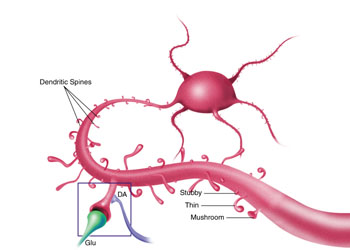
The illustrations show decreased dendritic spine density in a medium spiny neuron of the striatum. Below, the illustration represents the changes seen in Parkinson's disease or with experimental dopamine depletion, with decreased numbers of spines. (Dominic Doyle/Medical Art Group)
VUMC Parkinson’s research receives $5 million boost

Vanderbilt investigators have received a $5 million, five-year grant from the National Institute of Neurological Disorders and Stroke to study Parkinson’s disease. It is the largest grant the university has received for investigating the slowly progressive disease of the nervous system that affects about 1.2 million people in the United States and Canada.
“The overall focus of the grant is to understand the mechanisms that contribute to the loss of effectiveness of medications used to treat Parkinson’s disease and to try to arrive at interventions that will overcome or prevent this loss,” said Dr. Ariel Y. Deutch, professor of Psychiatry and Pharmacology, director of the Vanderbilt National Parkinson Foundation Center for Excellence and principal investigator of the grant. Other key Vanderbilt faculty include Roger J. Colbran, Ph.D., associate professor of Molecular Physiology and Biophysics, and Danny G. Winder, Ph.D., assistant professor of Molecular Physiology and Biophysics. Dr. Thomas J. Montine, who recently left Vanderbilt for the University of Washington, is also involved in the study.
Scientists have known for more than 40 years that the disease is characterized by the death of a small group of dopamine-producing neurons deep within the midbrain. Dopamine is a chemical messenger responsible for transmitting signals within the brain. The midbrain dopamine neurons send long fibers to a forebrain site called the striatum. When dopamine levels in the striatum fall below about 75 percent of normal, patients become unable to direct or control their movements in a normal manner. Although scientists know that the death of dopamine neurons causes Parkinson’s disease, they do not know what causes the death of these cells.
The early symptoms of Parkinson’s disease are subtle and occur gradually. They include tremor or trembling in hands, arms, legs, jaw, and face; rigidity or stiffness of the limbs and trunk; bradykinesia, or slowness of movement; and impaired balance and coordination.
Patients may also have difficulty walking, talking, or completing other tasks. The disease is both chronic and progressive. Parkinson’s disease is not usually inherited. For a number of years after diagnosis, patients respond well to dopamine replacement therapy with drugs such as levodopa (Sinemet) or other drugs that mimic the actions of dopamine. However, after a period of time, side effects of these drugs, including abnormal involuntary movements, develop and can become debilitating; still later the dopamine replacement drugs appear to lose their effectiveness. It is the late stages of the disease, when patients’ quality of life worsens, on which the Vanderbilt team is focusing their efforts.
The research team is directing attention to the cells in the striatum that receive dopamine inputs, on which receptors for dopamine are located. These striatal cells are called medium spiny neurons because their branches, called dendrites, are studded with thorn-like “spines.” The Vanderbilt group will be studying the loss of those spines, which occurs late in the course of Parkinson’s disease or in experimental conditions when striatal dopamine levels are sharply decreased. Interventions that slow progression of the disease and reverse the loss of spines could mean dramatic increases in the quality of life of many Parkinson’s patients.
“We’re trying to understand what contributes to the loss of spines and what can overcome or prevent the loss,” Deutch said.
The research will be multi-faceted with each investigator’s work building upon the findings of their co-investigators. The studies range from investigations of genetically engineered mice that lack dopamine receptors or key intracellular enzymes that are regulated by dopamine to studies of the calcium changes in medium spiny neurons. All the studies in experimental models of Parkinson’s disease are referenced to studies of postmortem brain samples from Parkinson’s disease patients.
“We hope this is going to really drive new efforts into research into Parkinson’s disease as well as related disorders,” Deutch said. “Parkinson’s is only one of the neurodegenerative disorders. Over the years we’ve gained an increasing appreciation for the number of common mechanisms that hold for neurodegenerative diseases. Once we find something that’s applicable to one, it often provides insights into others.”
Deutch said there is also a clear relationship to neuropsychiatric diseases, like schizophrenia. A common side effect of typical antipsychotic drugs used in the treatment of schizophrenia is parkinsonism, because the drugs block dopamine. Chronic treatment of animals with these drugs can also cause a loss of the spines on striatal neurons, while newer “atypical” antipsychotic drugs such as clozapine do not.
Deutch said there have been relatively few advances in the treatment of Parkinson’s since the introduction of levodopa about 35 years ago. “That (the introduction of levodopa) was a miracle. Patients went from incapacitated to virtually normal. It was truly remarkable,” Deutch said.
“Ultimately, what everybody wants to do, including us, is figure out the cause of Parkinson’s,” he said. “We know the immediate cause is loss of dopamine, but we don’t know what causes that or how to prevent Parkinson’s. While terrific advances have been made in understanding dopamine, the advances in the treatment of Parkinson’s have been incremental.”
Deutch said the Vanderbilt research might someday result in the delay or prevention of the late stage of Parkinson’s disease when patients suffer from more severe side effects and decreased response to therapeutic drugs.
“Dopamine replacement is not enough,” he said. “If it was, you wouldn’t end up with this problem (loss of response to dopamine) in the first place. We know you have to do something besides replace it. Will this translate into therapeutic intervention in five years? Realistically, no. It takes a considerable amount of time to come up with a therapeutic intervention. I’m optimistic that this will happen within 10 years. I think we’re entering the first volley into the battle.”













